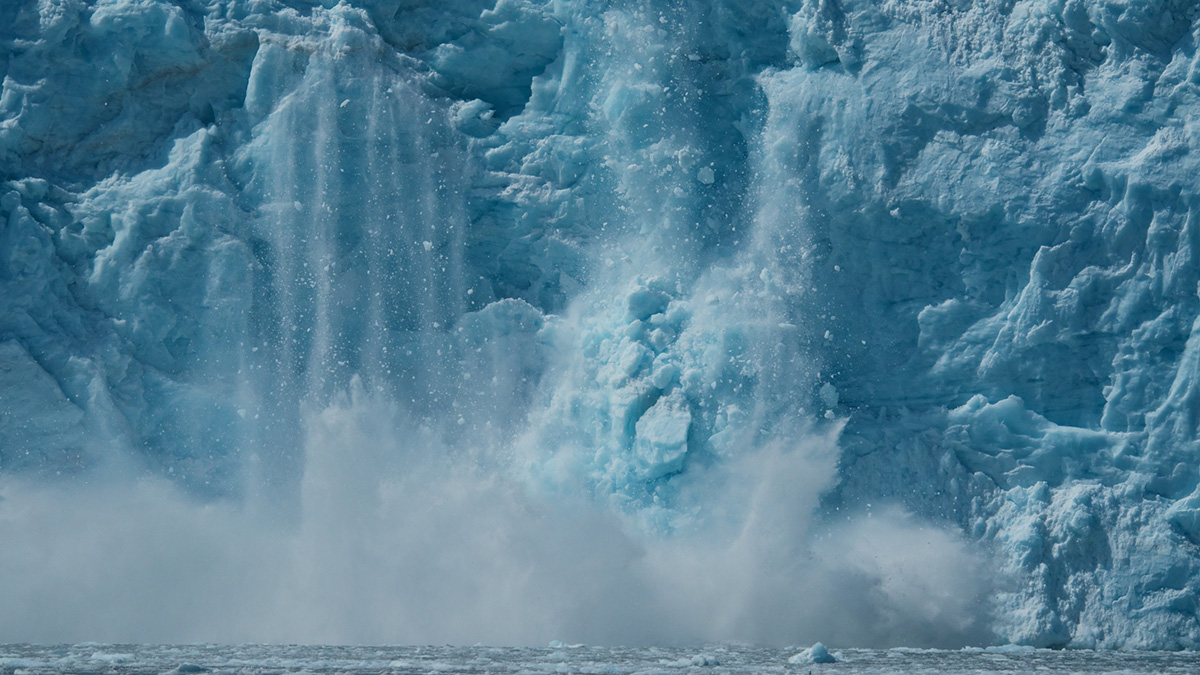When a slab breaks off the end of a glacier, the process starts with a small fracture. It ends in furious, booming thunder as great pillars of ice peel away and slam into the ocean. Monitoring these ruptures, a violent process called glacial calving, is critical to tracking and predicting sea level rise.
Cryosphere researchers Oskar Glowacki and Grant Deane are now harnessing the rumbles and splashes of glacial corrosion to quantify how much ice plunges into the ocean during calving events. They summarized their decade of work on passive cryoacoustics in a poster they will present at AGU’s Fall Meeting 2022.
It’s All About the Bubbles
The world’s largest tidewater glaciers flow from the mountains of Alaska and the inland ice sheets of Greenland and Antarctica. Their journeys to the coast may take hundreds or even thousands of years. But the journey’s end is sudden, as glacial slabs collapse into the sea.
“When an iceberg falls in the water, you get a lot of air entrained. All of those bubbles ring like little bells.”
The fractures themselves are deafening, but the science of passive cryoacoustics comes down to delicate bubbles bursting underwater. “All the sounds of running water—the babbling brook, the tinkling fountain, the crashing ocean waves—come from bubbles in the water,” said Deane, an oceanographer at Scripps Institution of Oceanography, University of California, San Diego. “When an iceberg falls in the water, you get a lot of air entrained. All of those bubbles ring like little bells,” which the scientists call singing.
Using those sounds, Glowacki, a researcher at the Institute of Geophysics, Polish Academy of Sciences, in Warsaw, created a way to calculate the volume of the singing blocks of ice.
Hydrophones to the Rescue
Monitoring calving is hard. Storms and shifting ice damage land-based equipment, and falling icebergs cause dangerous waves that can overturn boats. Satellite images show changes at glacial margins but reveal little about the volume of lost ice. Images on location depend on weather and light, and the polar night renders cameras useless.
In contrast, hydrophones for underwater recording are cheap and sturdy and don’t rely on ice stability. Scientists can easily deploy hydrophones, each the size of a wine cork attached to a 3-meter cable, from small rubber boats. If secured to the ocean floor with special moorings, the instruments can record for a year or more. “We don’t need to walk on glaciers,” said Glowacki. “You can listen to what is going on from a safe distance.”
Glowacki and Deane analyzed more than 650 calving events recorded by hydrophones deployed near the Hansbreen Glacier, which terminates in the Hornsund Fjord in Svalbard, a Norwegian archipelago.
Glowacki and Deane used time-lapse images, videos, radar soundings, and air and water temperatures to support their acoustic data.
“Concurrent underwater observations like these will be invaluable to our satellite analyses, which are useful for the ‘big picture’ but often miss the small-scale, local effects,” said Catherine Walker, a glaciologist at Woods Hole Oceanographic Institution in Massachusetts who was not associated with the new work.
Extracting Signals from a Noisy Ocean
Deploying the equipment is easy. “The hard part starts when you are trying to understand what you are listening to,” said Glowacki. Oceans are noisy. Breaking waves, vocalizing marine mammals, storms, and ships all contribute to the underwater soundscape. Then there are the calving noises themselves—first when the ice detaches, then when it slams into the sea. All of these noises contribute to a cacophony beneath the waves.
“Acoustics is the only metric we are aware of that can capture both calving and melting.”
Different physical mechanisms produce distinctive sounds, which the researchers can discern amid the noise. A calving iceberg rumbles deeply at a low frequency, whereas splashes and bubbles produce higher frequencies, Glowacki explained. Complex mathematical analysis yields a size calculation for each icy discharge.
The scientists tested the approach by comparing theoretical calculations to recordings from two sources: ice blocks of known sizes dropped into a laboratory pool at Scripps in San Diego and real calving events at Hansbreen.
Cryoacoustics is also useful for studying melting, the other main way ice sheets shed mass into the ocean. “Acoustics is the only metric we are aware of that can capture both calving and melting,” said Glowacki. Melting is still about bubbles, he noted: Tiny pockets of air get trapped within glacier ice, and as the ice melts underwater, those bubbles explode with great force. The resulting steady fizz sounds like bacon frying, said Deane. Other scientists call it bergy seltzer.
Glaciers move at, well, a glacial pace. But the need to monitor their movement is urgent. If Greenland’s ice sheet melted, it would raise the world’s sea level by 7 meters, said Deane. “Even modest sea level rise is a cause for concern,” he said.
—Elise Overgaard (@elise_overgaard), Science Writer


